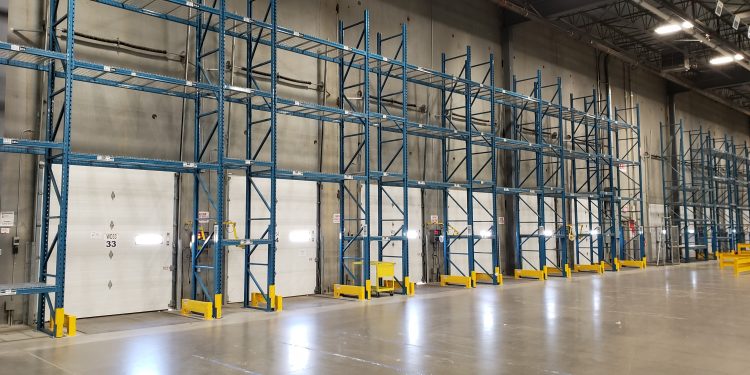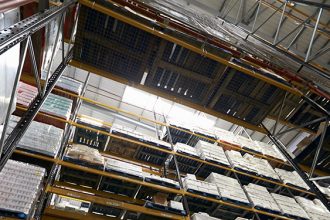Put Over-the-Dock Space to Use

A cost-effective way to making use of empty space, over-the-dock storage is at your fingertips.
If things are beginning to get a bit tight in your warehouse or production facility, you might be overlooking one of the easiest places to gain a little space: over your dock doors. Yes, it’s a hub of activity, bustling with incoming an outgoing shipments, but it is free, available space to solve your growing pains. To get it right, however, you’ll need some tried and true guidance from racking experts.
“Over-the-dock storage can be a good fit for almost any distribution center,” says Jeff Howard, vice president of sales and marketing at Advance Storage Products. “Space is at a premium in most facilities, and this allows you to maximize your otherwise unusable space.”
Exactly how much space you can gain with over-the-dock storage varies from building to building and operation to operation. But in general, says Jonathan Hirst, vice president and general manager at North American Storage Equipment. “Buildings are getting taller every year, but the dock doors remain at about 10-feet tall,” he explains. “So if you have a 40- or 50-ft tall building and a 10-ft tall door, that’s a lot of space you can put to good use.”
What you store in over-the-dock racking will vary, as well, but a good application is to place your various packing and shipping materials in these spaces. Think empty pallets, packing materials and other supplies that are both useful near the dock, but generally not products that need to move in and out of the DC or exist in different types or racking than what you might use over the dock door. “We often see a lot of cardboard boxes stored here, or wrapping and packing materials,” says Ray Niemeyer, vice president of sales and marketing at Space Guard Products. “Other options might be long-term storage items you don’t need to reach quickly.”
Howard, who has many customers in the cold storage arena, says that over-the-dock racking can be ideal for products that don’t need specialized storage. “If you’ve got a big cube of cooler or freezer space, that’s expensive space,” he says. “You don’t want to use that for anything other than product requiring that climate enhancement. That’s where the dock area can be great for a bunch of empty pallets and similar items.”
Over-the-dock racking in practice
That’s the long and short of what you might want to store on this new, gained space. But how do you configure it and what type of racking should you install over your docks? There are several ways to go about it.
One of the easiest types of racking to install over your docks is conventional racking, using standard pallet uprights placed between the dock doors. The bays are then decked above the doors. “The most common configuration here will be selective rack, single deep,” says Hirst. “You’ll want to set it up at least 24 to 36 inches off the wall to allow room for the overhead door to pass and away from chains, rollers and the like.”
Another option is to install a suspended pallet rack. Starting at the ceiling, the rack hangs down and attaches to the wall above the doors. While a creative solution, it’s usually one reserved for greenfield facilities rather than a more difficult—or sometimes impossible—retrofit. Most brownfield buildings won’t have a roof designed to handle that kind of load.
For some facilities, another option is a single leg offset design. “One issue with using space above the doors is that there’s often a lot going on here,” says Howard. “You might have sprinklers, electrical boxes, or electronics that control the doors themselves here. So, if you use a single leg on the floor that goes up and then widens out, to your storage space you’ll solve that issue.”
Still, the potential for instability in this design exists, so securing it to the wall is critical. “You must make sure the racking can handle the loads without pulling away from the wall,” says Howard. “Check with your building designer to know what structural items can take it.”
Important considerations
Having a building and/or safety engineer involved, along with your racking experts, will be essential to safe and efficient design of your over-the-dock storage areas. No matter which option you’re using, there are important safety measures to take around the dock doors. “You’re going to have a lot of forklift traffic here, so you must protect the racking well,” says Hirst.
Niemeyer agrees. “Think about guarding on the back side, because if it’s not there, what could get damaged?” he asks. “You’ve got the vertical door, the door track, the panels, the motor, or all of the above at stake.”
Additionally, you’ll need to ensure that whatever you are storing above the docks doesn’t fall and end up in the dock area. “You need a fence, a net, or backstop beams for safety, depending on what you’ll be storing,” says Hirst.
To understand how to use rack guarding—anything attached to the uprights, backs or sides of pallet racks—it can be useful to reference the standard developed by Niemeyer’s working group, the Protective Guarding Manufacturer’s Association. Recognized as ANSI Standard MH31.1, the guide defines safe loads, impact deflection and the like to ensure containment and safety around racking, essential over the dock.
One more consideration that is easy to overlook, says Niemeyer, is regular scheduled maintenance in the dock area. “Know the schedule so that you can communicate to the warehouse team in advance, and they can make sure the over—dock-storage racks are clear,” he says. “If you don’t, you might be at risk for extra bills from your service contractor.”
With some collaborative approaches, you can put lost space to work over your dock doors safely, as well as cost effectively.


